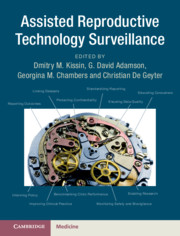Book contents
- Frontmatter
- Contents
- Foreword
- List of Contributors
- Section 1 Introduction to ART Surveillance
- Section 2 General Principles of ART Surveillance
- 3 ART Surveillance: Who, What, When and How?
- 4 Future Directions for ART Surveillance and Monitoring Novel Technology
- Section 3 Using ART Surveillance Data
- Section 4 Global Variations in ART Surveillance
- Section 5 Surveillance of Non-ART Fertility Treatments
- Appendix A ART Surveillance System Variables and Definitions
- Appendix B International Glossary on Infertility and Fertility Care
- Appendix C ICMART Data Collection Form
- Index
- Plates
4 - Future Directions for ART Surveillance and Monitoring Novel Technology
from Section 2 - General Principles of ART Surveillance
Published online by Cambridge University Press: 14 June 2019
- Frontmatter
- Contents
- Foreword
- List of Contributors
- Section 1 Introduction to ART Surveillance
- Section 2 General Principles of ART Surveillance
- 3 ART Surveillance: Who, What, When and How?
- 4 Future Directions for ART Surveillance and Monitoring Novel Technology
- Section 3 Using ART Surveillance Data
- Section 4 Global Variations in ART Surveillance
- Section 5 Surveillance of Non-ART Fertility Treatments
- Appendix A ART Surveillance System Variables and Definitions
- Appendix B International Glossary on Infertility and Fertility Care
- Appendix C ICMART Data Collection Form
- Index
- Plates
Summary
In many areas activities in assisted reproductive technology (ART) are being recorded and analyzed by registries, either on a voluntary or compulsory basis , and reports are generated producing cross-sectional data on an annual basis. Current ART is now developing towards a segmented longitudinal approach, in which single therapeutic steps are spread over prolonged time intervals, necessitating a cumulative approach in the handling of ART-data. This requires a unique identifier for each individual seeking fertility care together with an informed and signed consent. The identifier should reside with the institution offering fertility treatment and follow the infertile individual through the various therapeutic steps, even if leaving to another institution. The identifier should be added to all data submitted to the ART registry. This will allow the national health register to construct cumulative outcome data on all forms of fertility treatment, including long-term gamete and tissue freezing-related information.
- Type
- Chapter
- Information
- Assisted Reproductive Technology Surveillance , pp. 31 - 36Publisher: Cambridge University PressPrint publication year: 2019

